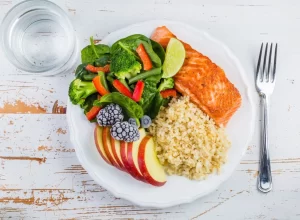Portion Distortion and How to Overcome It
 There are a lot of reasons why many of us may struggle with weight issues. Portion sizes in the US are a major contributor to this issue. Portion sizes have been getting bigger and bigger over the past decade and only recently there has been a push to minimize this growth. An issue that stemmed from this growth is portion distortion. The definition of Portion distortion is the normalization of the enormous portions we are served in restaurants, fast food, and even at home. Most meals for one person at a restaurant can feed two or three people and have more than a day’s worth of sodium and calories in each meal depending on where you go. This practice has unfortunately become very standardized, and it is hard to avoid. For example, a kid’s meal at McDonald’s used to be the standard size of adult meals. The adult meal at McDonald’s in the 50’s from when it first opened was only around 300 or so calories, whereas now a meal can be upwards to 1,200 calories. Eventually, the effects of portion distortion will lead to habitual overeating. One of many negative side effects of habitual overeating is the inhibition of the hormone leptin which lets you know you are feeling full. When you are constantly eating large portions of food and ignoring your body’s signals you will lose the ability to gauge whether you are full, and it is harder to stop when you need to. The good news is that it is not permanent and there are steps to curve this and get back to a normal eating pattern.
There are a lot of reasons why many of us may struggle with weight issues. Portion sizes in the US are a major contributor to this issue. Portion sizes have been getting bigger and bigger over the past decade and only recently there has been a push to minimize this growth. An issue that stemmed from this growth is portion distortion. The definition of Portion distortion is the normalization of the enormous portions we are served in restaurants, fast food, and even at home. Most meals for one person at a restaurant can feed two or three people and have more than a day’s worth of sodium and calories in each meal depending on where you go. This practice has unfortunately become very standardized, and it is hard to avoid. For example, a kid’s meal at McDonald’s used to be the standard size of adult meals. The adult meal at McDonald’s in the 50’s from when it first opened was only around 300 or so calories, whereas now a meal can be upwards to 1,200 calories. Eventually, the effects of portion distortion will lead to habitual overeating. One of many negative side effects of habitual overeating is the inhibition of the hormone leptin which lets you know you are feeling full. When you are constantly eating large portions of food and ignoring your body’s signals you will lose the ability to gauge whether you are full, and it is harder to stop when you need to. The good news is that it is not permanent and there are steps to curve this and get back to a normal eating pattern.
- Eat slowly. Your body takes about 20 minutes to send the signal to your brain to let it know that it is full.
- Drink water between bites. This will not only help with digestion, but it will also allow you time to pause between each bit so you don’t start eating too fast.
- Stop eating when you feel about 80% full.
- If you are eating out get a side of veggies or put half your plate in a to-go box right away.
- Another trick if you are eating out has a higher protein meal a few hours before you go out. This will help you eat less because the protein will keep you more satiated, so you don’t overeat.
- Drink a glass of water before you eat. Sometimes when you’re feeling hungry you may actually just be thirsty. Drink some water and wait 10-20 minutes. If you still feel hungry then eat, if not you were just thirsty.
Tips for estimating portion sizes:
- The palm of your hand is roughly 3-4 oz of meat/plant-based meat
- Your thumb is 2 Tbsp, and the tip of your index finger is 1 tsp
- A clenched fist is about 1 cup of grains
- The front of your fist is roughly 1/2 cup
